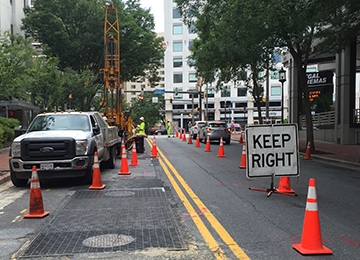After 28 years of experience completing transportation-related geotechnical design phase services and construction-phase testing services, ECS is proud to celebrate the 2017 National Work Zone Awareness – “Work Zone Safety Is in Your Hands” Week. As we take pride in our experience and emphasis on work zone safety, we wanted to share some of our takeaways.
On our bridge and roadway projects, it is very important that our workers, our subcontractors, and the general public are not exposed to unnecessary safety risks. To accomplish this, we utilize certified Maintenance of Traffic (MOT) subcontractors that specialize in work zone safety and are well versed in Manual for Uniform Traffic Control Devices (MUTCD).
Typically, ECS provides geotechnical services during pre-design and design phases of transportation projects. We emphasize safety with road and bridge projects because our presence is less obvious to the traveling public. At the time of our work there is less equipment and personnel on the site when compared with the volume and location of equipment and people onsite during the construction phase. We collaborate with our own safety representatives, on-site personnel, and our clients’ safety representatives to perform two key activities:
- “Toolbox” safety and MOT briefings before traffic control set up, and
- “Drive-through” audits of our own work zone set ups before commencing work
These activities are maintained for the duration of our services where work zone safety is needed. The briefings and drive-through exercises identify areas of improvement as we place ourselves in the point-of-view of a motorist driving through the work zone.
For larger projects like I-385/I-485 connector in SC and the MTA Purple Line in Montgomery and Prince Georges Counties in MD, ECS completes a Job Hazard Analysis (JHA) for each day of work. The daily JHA forms note each boring location, potential MOT needs, work zone impacts, working hour restrictions, personnel establishing the MOT devices, etc.
It is important to note that sometimes JHA forms, “toolbox” safety and MOT briefings, and meeting the minimum guidelines per MUTCD aren’t enough. In some cases, procedures other than those typically implemented are employed to address the activities for the day. One example is an extension or lengthening of cone tapers and/or the location and number of truck-mounted attenuators (TMAs) on a curved section of a primary or secondary route.
While we support the transportation market with design-phase services, establishing and maintaining safe work zones is very important. These measures help keep our people, our subcontractors, our client’s personnel, and the traveling public safe. Work zone safety is a responsibly we take very seriously.
Author: Randy Wirt, PE, Director of Engineering, ECS Special Projects Group
Mr. Wirt has spent close to 20 years providing geotechnical and construction monitoring services on a variety of transportation projects in the Mid-Atlantic region. His experience includes work in a variety of geologic and geotechnical settings and includes over 250 transportation projects and over 150 bridge projects including small bridge replacement design-bid-build projects to larger, more complex and high profile design-build transportation projects. He specializes in the design and evaluation of shallow and deep foundation systems, permanent and temporary retaining structures, ground improvement methodologies, and geotechnical aspects of construction.

